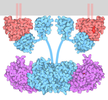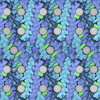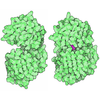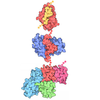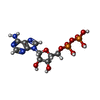+ Open data
Open data
- Basic information
Basic information
| Entry | Database: PDB / ID: 9ejm | ||||||
|---|---|---|---|---|---|---|---|
| Title | Lgl2 bound to the aPKCiota-Par6B complex in its ADP-bound form | ||||||
 Components Components |
| ||||||
 Keywords Keywords | LIPID BINDING PROTEIN / Cell Polarity / Kinase / Complex | ||||||
| Function / homology |  Function and homology information Function and homology informationestablishment of spindle orientation / establishment or maintenance of polarity of embryonic epithelium / diacylglycerol-dependent, calcium-independent serine/threonine kinase activity / Golgi vesicle budding / PAR polarity complex / Tight junction interactions / regulation of establishment or maintenance of cell polarity / protein kinase C / establishment of apical/basal cell polarity / diacylglycerol-dependent serine/threonine kinase activity ...establishment of spindle orientation / establishment or maintenance of polarity of embryonic epithelium / diacylglycerol-dependent, calcium-independent serine/threonine kinase activity / Golgi vesicle budding / PAR polarity complex / Tight junction interactions / regulation of establishment or maintenance of cell polarity / protein kinase C / establishment of apical/basal cell polarity / diacylglycerol-dependent serine/threonine kinase activity / L-leucine transport / myosin II binding / regulation of Notch signaling pathway / negative regulation of glial cell apoptotic process / eye photoreceptor cell development / branching involved in labyrinthine layer morphogenesis / Schmidt-Lanterman incisure / establishment or maintenance of epithelial cell apical/basal polarity / Golgi to plasma membrane transport / membrane organization / cellular response to chemical stress / cell-cell junction organization / cortical actin cytoskeleton organization / protein targeting to membrane / tight junction / labyrinthine layer blood vessel development / cortical actin cytoskeleton / positive regulation of Notch signaling pathway / establishment of cell polarity / cell leading edge / exocytosis / brush border / positive regulation of endothelial cell apoptotic process / positive regulation of glial cell proliferation / bicellular tight junction / regulation of postsynaptic membrane neurotransmitter receptor levels / intercellular bridge / vesicle-mediated transport / cytoskeleton organization / secretion / p75NTR recruits signalling complexes / response to interleukin-1 / GTPase activator activity / actin filament organization / positive regulation of D-glucose import / post-embryonic development / protein localization to plasma membrane / positive regulation of protein localization to plasma membrane / PDZ domain binding / adherens junction / positive regulation of NF-kappaB transcription factor activity / positive regulation of neuron projection development / phospholipid binding / Pre-NOTCH Transcription and Translation / Schaffer collateral - CA1 synapse / multicellular organism growth / cellular response to insulin stimulus / KEAP1-NFE2L2 pathway / cell migration / microtubule cytoskeleton / negative regulation of neuron apoptotic process / protein phosphorylation / protein kinase activity / endosome / intracellular signal transduction / cilium / apical plasma membrane / Golgi membrane / cell division / protein serine kinase activity / intracellular membrane-bounded organelle / protein serine/threonine kinase activity / negative regulation of apoptotic process / glutamatergic synapse / extracellular exosome / zinc ion binding / nucleoplasm / ATP binding / nucleus / plasma membrane / cytoplasm / cytosol Similarity search - Function | ||||||
| Biological species |  Homo sapiens (human) Homo sapiens (human) | ||||||
| Method | ELECTRON MICROSCOPY / single particle reconstruction / cryo EM / Resolution: 3.33 Å | ||||||
 Authors Authors | Almagor, L. / Weis, W.I. | ||||||
| Funding support | 1items
| ||||||
 Citation Citation |  Journal: Commun Biol / Year: 2025 Journal: Commun Biol / Year: 2025Title: Polarity protein Par6 facilitates the processive phosphorylation of Lgl via a dynamic interaction with aPKC. Authors: Lior Almagor / William I Weis /  Abstract: Polarity along an apical-basal axis is essential for epithelial cell shape and function. The atypical protein Kinase-C (aPKC) and its regulatory partner Par6 form a complex that is essential for ...Polarity along an apical-basal axis is essential for epithelial cell shape and function. The atypical protein Kinase-C (aPKC) and its regulatory partner Par6 form a complex that is essential for polarization, a primary function of which is to phosphorylate the Lethal giant larvae (Lgl) protein to prevent it from binding to the apical membrane (thereby facilitating its basolateral localization). Par6 binds Lgl directly and is essential for this process, but its mechanism was obscure. Here, we utilize cryo-EM and various biochemical techniques to characterize the interaction of Lgl2 with the aPKCι/Par6 complex and to study the roles of Par6 in promoting Lgl2 phosphorylation. We find that Par6 proteins stabilize a ternary Lgl2/aPKCι/Par6 complex that involves a unique multi-surface interaction of Lgl2 with both aPKCι and Par6. Importantly, we find Par6b induces processive phosphorylation that results in a multi-phosphorylated Lgl2 after a single interaction with the aPKCι/Par6b complex. This is enabled by a Par6b/Lgl2 interaction that maintains contact of Lgl2 with the kinase throughout its distinct nucleotide-binding states. Our results reveal the mechanistic basis for the efficient regulation of Lgl's membrane binding by aPKC/Par6 and provide invaluable structural data for further understanding the mechanisms of this polarity complex. | ||||||
| History |
|
- Structure visualization
Structure visualization
| Structure viewer | Molecule:  Molmil Molmil Jmol/JSmol Jmol/JSmol |
|---|
- Downloads & links
Downloads & links
- Download
Download
| PDBx/mmCIF format |  9ejm.cif.gz 9ejm.cif.gz | 281.1 KB | Display |  PDBx/mmCIF format PDBx/mmCIF format |
|---|---|---|---|---|
| PDB format |  pdb9ejm.ent.gz pdb9ejm.ent.gz | 211.2 KB | Display |  PDB format PDB format |
| PDBx/mmJSON format |  9ejm.json.gz 9ejm.json.gz | Tree view |  PDBx/mmJSON format PDBx/mmJSON format | |
| Others |  Other downloads Other downloads |
-Validation report
| Arichive directory |  https://data.pdbj.org/pub/pdb/validation_reports/ej/9ejm https://data.pdbj.org/pub/pdb/validation_reports/ej/9ejm ftp://data.pdbj.org/pub/pdb/validation_reports/ej/9ejm ftp://data.pdbj.org/pub/pdb/validation_reports/ej/9ejm | HTTPS FTP |
|---|
-Related structure data
| Related structure data |  48105MC  9ejkC  9ejlC M: map data used to model this data C: citing same article ( |
|---|---|
| Similar structure data | Similarity search - Function & homology  F&H Search F&H Search |
- Links
Links
- Assembly
Assembly
| Deposited unit | 
|
|---|---|
| 1 |
|
- Components
Components
| #1: Protein | Mass: 109362.188 Da / Num. of mol.: 1 Source method: isolated from a genetically manipulated source Source: (gene. exp.)  Homo sapiens (human) / Gene: LLGL2 / Cell line (production host): Sf9 / Production host: Homo sapiens (human) / Gene: LLGL2 / Cell line (production host): Sf9 / Production host:  |
|---|---|
| #2: Protein | Mass: 68512.258 Da / Num. of mol.: 1 Source method: isolated from a genetically manipulated source Source: (gene. exp.)  Homo sapiens (human) / Gene: PRKCI, DXS1179E / Cell line (production host): Sf9 / Production host: Homo sapiens (human) / Gene: PRKCI, DXS1179E / Cell line (production host): Sf9 / Production host:  |
| #3: Protein | Mass: 42472.445 Da / Num. of mol.: 1 Source method: isolated from a genetically manipulated source Source: (gene. exp.)   |
| #4: Chemical | ChemComp-ADP / |
| #5: Chemical | ChemComp-MG / |
| Has ligand of interest | Y |
| Has protein modification | Y |
-Experimental details
-Experiment
| Experiment | Method: ELECTRON MICROSCOPY |
|---|---|
| EM experiment | Aggregation state: PARTICLE / 3D reconstruction method: single particle reconstruction |
- Sample preparation
Sample preparation
| Component |
| ||||||||||||||||||||||||
|---|---|---|---|---|---|---|---|---|---|---|---|---|---|---|---|---|---|---|---|---|---|---|---|---|---|
| Source (natural) |
| ||||||||||||||||||||||||
| Source (recombinant) |
| ||||||||||||||||||||||||
| Buffer solution | pH: 8 | ||||||||||||||||||||||||
| Specimen | Conc.: 0.2 mg/ml / Embedding applied: NO / Shadowing applied: NO / Staining applied: NO / Vitrification applied: YES Details: 20 mM Tris 200 mM NaCl 1 mM DTT 10 mM MgCl2 1 mM ADP 10 uM ZnCl2 0.05% n-octyl-beta-D-glucoside | ||||||||||||||||||||||||
| Specimen support | Grid material: GOLD / Grid type: Quantifoil R1.2/1.3 | ||||||||||||||||||||||||
| Vitrification | Instrument: FEI VITROBOT MARK IV / Cryogen name: ETHANE / Humidity: 100 % / Chamber temperature: 295 K |
- Electron microscopy imaging
Electron microscopy imaging
| Experimental equipment |  Model: Titan Krios / Image courtesy: FEI Company |
|---|---|
| Microscopy | Model: TFS KRIOS / Details: Data collected at both 25 and 40 degrees tilt |
| Electron gun | Electron source:  FIELD EMISSION GUN / Accelerating voltage: 300 kV / Illumination mode: FLOOD BEAM FIELD EMISSION GUN / Accelerating voltage: 300 kV / Illumination mode: FLOOD BEAM |
| Electron lens | Mode: BRIGHT FIELD / Nominal magnification: 81000 X / Nominal defocus max: 3500 nm / Nominal defocus min: 1300 nm / Calibrated defocus min: 1300 nm / Calibrated defocus max: 3500 nm / Cs: 2.7 mm / C2 aperture diameter: 100 µm |
| Image recording | Electron dose: 65 e/Å2 / Film or detector model: GATAN K3 (6k x 4k) |
- Processing
Processing
| EM software |
| |||||||||
|---|---|---|---|---|---|---|---|---|---|---|
| CTF correction | Type: PHASE FLIPPING AND AMPLITUDE CORRECTION | |||||||||
| 3D reconstruction | Resolution: 3.33 Å / Resolution method: FSC 0.143 CUT-OFF / Num. of particles: 787439 / Symmetry type: POINT |
 Movie
Movie Controller
Controller







 PDBj
PDBj